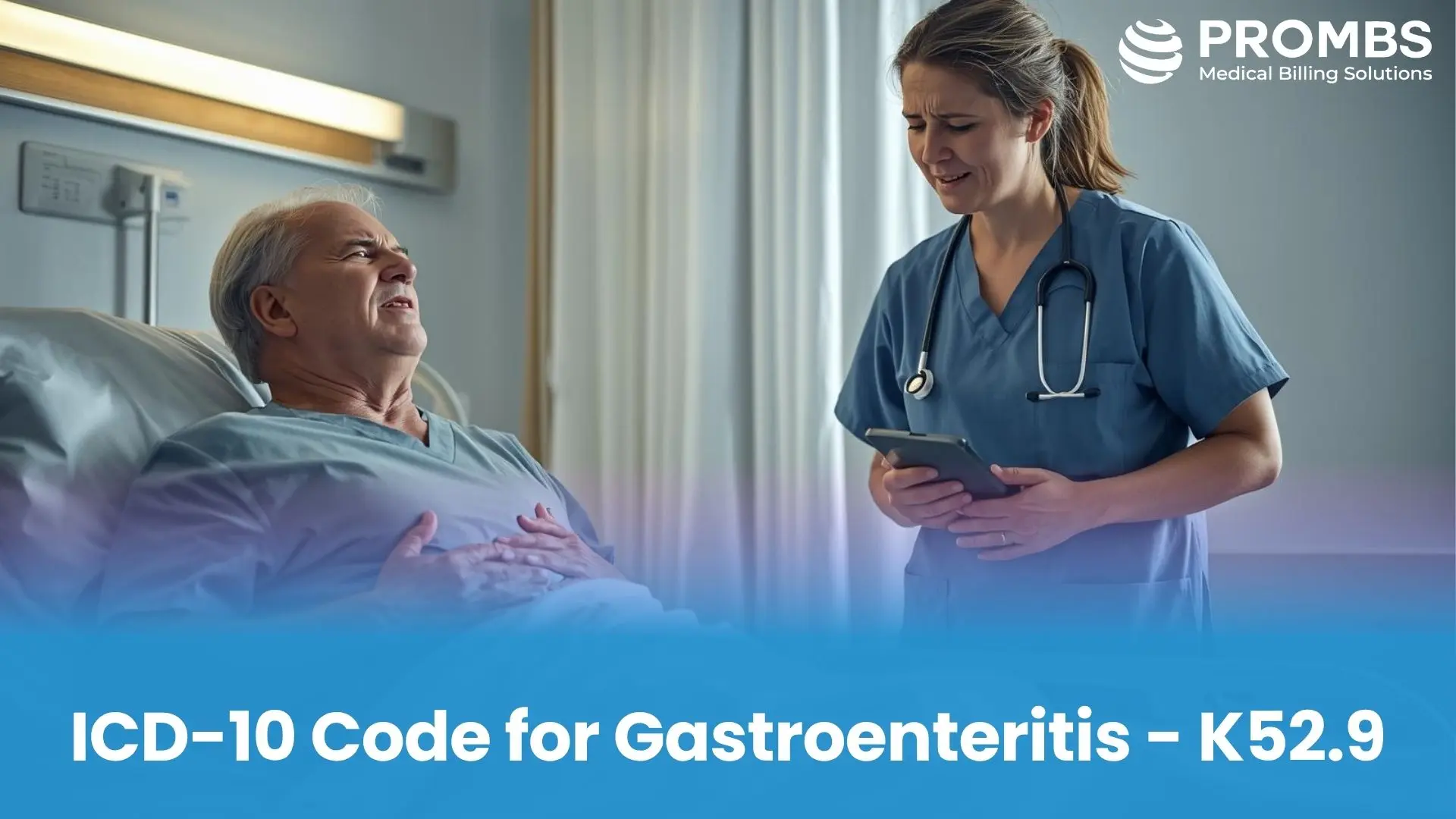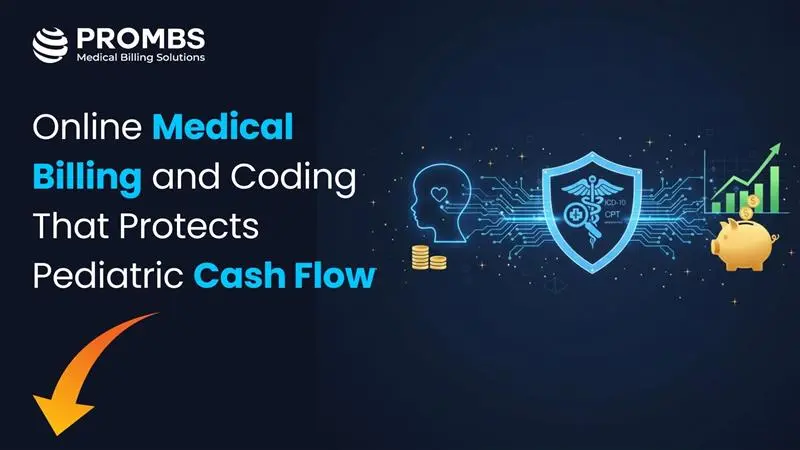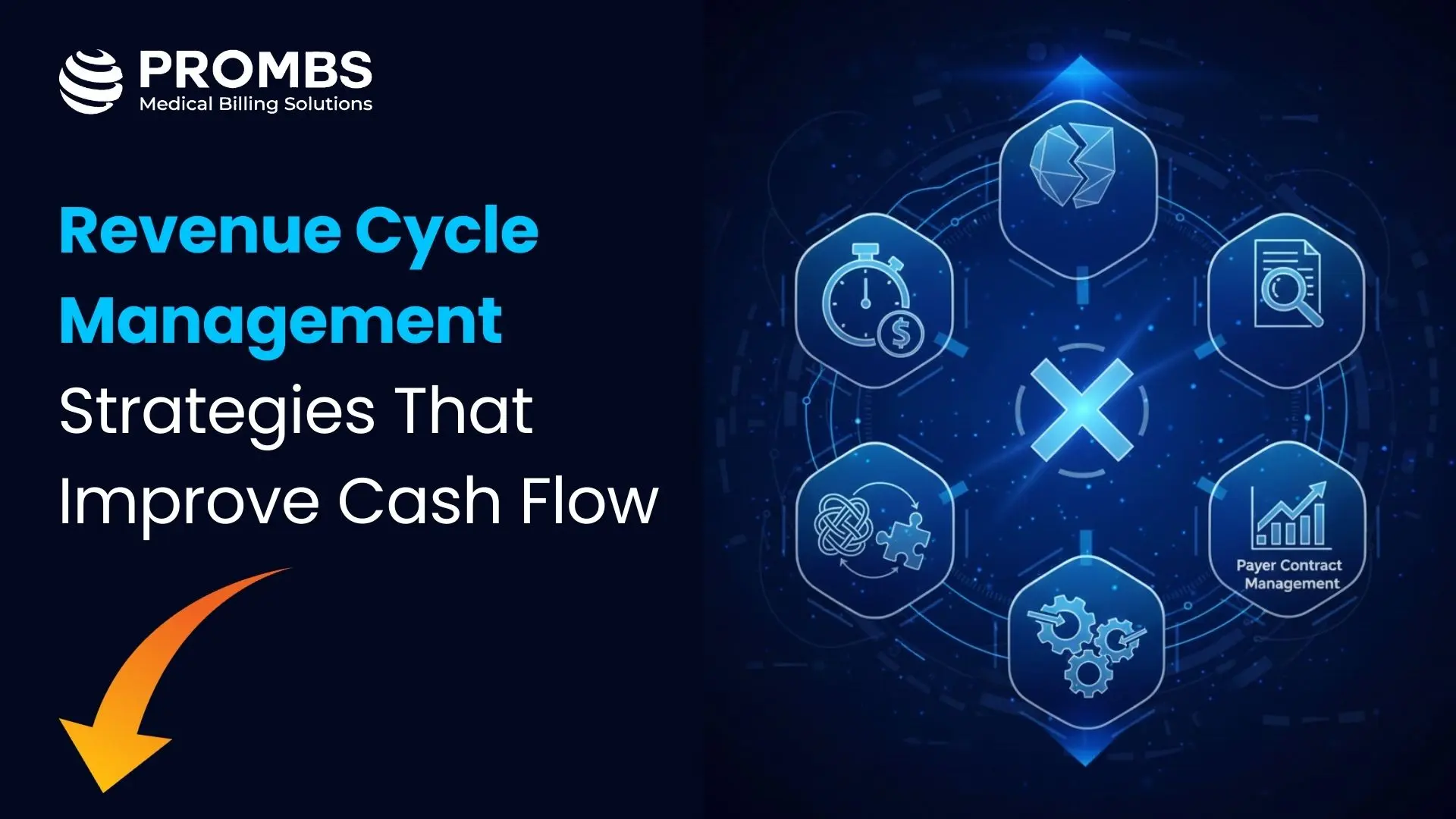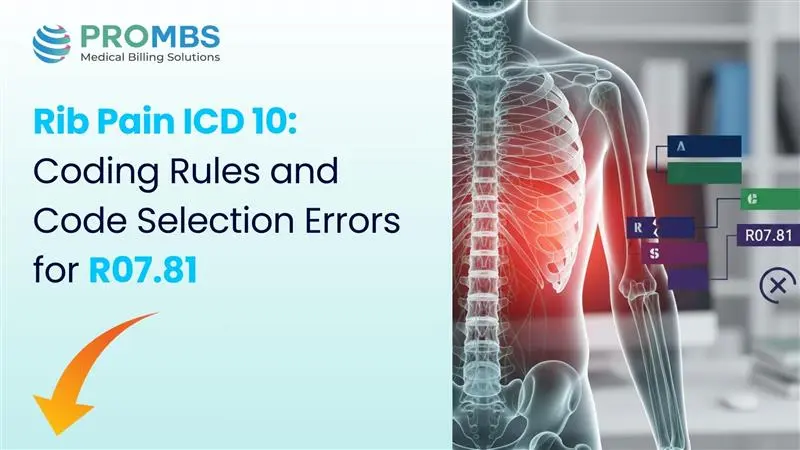Gastroenteritis, commonly referred to as the “stomach flu”, is one of the most frequently billed gastrointestinal conditions across urgent care centers, emergency departments, and primary care practices. According to the Centers for Disease Control and Prevention (CDC), norovirus alone causes approximately 19–21 million gastroenteritis cases annually in the U.S., leading to over 1.7 million outpatient visits. For coders, this translates into constant use of the icd 10 code for gastroenteritis and its subcategories in claims.
From a revenue cycle perspective, gastroenteritis matters because it spans infectious, noninfectious, acute, and chronic categories. Choosing between codes like A09 (infectious gastroenteritis) and K52.9 (noninfectious gastroenteritis, unspecified) directly impacts claim acceptance. CMS data show that digestive system disorders are high-volume diagnoses, and improper use of the icd 10 code for gastroenteritis contributes to preventable denials each year.
What Is Gastroenteritis and What Are Its Symptoms?
Gastroenteritis is an inflammatory condition of the stomach and intestines that leads to acute disturbances of the gastrointestinal tract. The icd 10 code for gastroenteritis is frequently applied in outpatient, emergency, and inpatient encounters because the condition is among the most common reasons patients seek medical care worldwide. As the World Health Organization (WHO) reports, diarrheal diseases including gastroenteritis remain a leading cause of morbidity, accounting for millions of hospital visits annually.
Clinically, gastroenteritis is not limited to a single etiology. It may be infectious, caused by viruses such as norovirus and rotavirus, bacteria like Salmonella or E. coli, or parasites such as Giardia. It can also be noninfectious, triggered by food allergies, medication side effects, or autoimmune conditions such as inflammatory bowel disease. The Mayo Clinic explains that viral gastroenteritis is particularly contagious and spreads rapidly through contaminated food, water, or person-to-person contact, making it one of the most significant public health challenges in gastroenterology.
| Symptom | Clinical Presentation | Coding Relevance |
|---|---|---|
| Diarrhea | Frequent, watery stools, often the primary complaint. The World Health Organization identifies diarrhea as the hallmark of gastroenteritis globally. | Core indicator supporting the ICD-10 code for gastroenteritis (A09, K52.9). Distinguishes gastroenteritis from IBS or constipation, consistent with ICD10Data’s explanations. |
| Nausea and Vomiting | Acute onset, especially with viral gastroenteritis such as norovirus, which the CDC lists as a leading cause of stomach flu. | Confirms an infectious process; documentation of severity justifies medical necessity for interventions like IV fluids, as noted in AMA CPT guidelines. |
| Abdominal Cramps and Pain | Diffuse or localized abdominal pain, reflecting intestinal irritation. The Mayo Clinic highlights cramping as a frequent symptom. | Important for differentiating gastroenteritis from appendicitis or pancreatitis; supports ICD-10 specificity when assigning codes like A09 or K52.9, per CMS coding guidance. |
| Fever and Malaise | Low- to high-grade fever, fatigue, and systemic discomfort, often seen in bacterial gastroenteritis. The Cleveland Clinic notes fever as a red-flag symptom requiring closer evaluation. | Supports coding of infectious gastroenteritis (A09) or specific viral causes such as A08.0 (rotaviral enteritis), in line with ICD10Data details. |
| Dehydration | Signs include dry mucosa, decreased urination, tachycardia, and orthostatic hypotension. The CDC warns dehydration is the most serious complication of gastroenteritis. | Critical for supporting higher-level claims; coders can link dehydration to CPT 96360 (IV hydration) when properly documented, consistent with AMA CPT coding resources. |
What Is the ICD-10 Code for Gastroenteritis and What Does It Mean?
The icd 10 code for gastroenteritis is not a single code but a cluster of codes that capture infectious, noninfectious, and cause-specific variations. Selecting the correct code requires careful review of documentation to confirm whether the condition is infectious or noninfectious, whether a specific pathogen has been identified, and whether external factors like food allergies or medications are involved.
According to the CMS ICD-10-CM Official Guidelines, coders must choose the highest level of specificity supported by the provider’s note. This means that if the lab confirms norovirus, coding A08.11 (acute gastroenteritis due to Norwalk agent) is more accurate than using the unspecified A09. Likewise, if the case is noninfectious, coders must move into the K52 category rather than leaving it under infectious diseases. The World Health Organization (WHO) defines A09 as “infectious gastroenteritis and colitis, unspecified,” while ICD10Data clarifies that K52.9 refers to “noninfective gastroenteritis and colitis, unspecified.” Using these codes interchangeably without documentation proof is one of the most common reasons for payer denials in gastrointestinal billing.
| ICD-10 Code | Clinical Meaning | Example Use Case | Coding Notes |
|---|---|---|---|
| A09 | Infectious gastroenteritis and colitis, unspecified, as described by the WHO ICD-10 index. | A patient presents with diarrhea, fever, and dehydration, but no stool test results yet. | Use when infection is suspected but organism is not identified; avoid if lab results confirm a specific virus or bacteria. |
| K52.9 | Noninfectious gastroenteritis and colitis, unspecified, defined by ICD10Data. | A patient with gastroenteritis linked to a drug reaction or food intolerance. | Do not use alongside infectious codes; payers may deny if infection evidence exists in the chart. |
| A08.0 | Rotaviral enteritis, recognized in CDC rotavirus data. | Child with lab-confirmed rotavirus infection and dehydration. | Use specific pathogen code when available to support medical necessity for hospitalization or IV therapy. |
| A08.11 | Acute gastroenteritis due to Norwalk agent (norovirus), outlined in ICD10Data. | Adult with positive stool PCR for norovirus during outbreak. | Using a specific viral code helps justify ED visits and hydration therapy, reducing denial risk. |
| K52.2 | Allergic and dietary gastroenteritis and colitis, listed under CMS ICD-10 coding guidance. | A patient develops diarrhea after consuming shellfish, no infection detected. | Important for allergy-related or dietary-triggered gastroenteritis; pairs with outpatient management CPT codes. |
Which ICD-10 Chapter Includes Gastroenteritis?
The icd 10 code for gastroenteritis can appear in two different ICD-10 chapters, depending on whether the cause is infectious or noninfectious. If the gastroenteritis is infectious, it belongs in Chapter I: Certain Infectious and Parasitic Diseases (A00–B99). If the gastroenteritis is noninfectious, it belongs in Chapter XI: Diseases of the Digestive System (K00–K95).
The CMS ICD-10-CM guidelines emphasize that coders must always review chapter-specific instructions, inclusion terms, and Excludes1/Excludes2 notes. For example, infectious gastroenteritis (A09, A08.x) cannot be coded simultaneously with noninfectious gastroenteritis (K52.x) in the same encounter, since the ICD-10-CM structure treats them as mutually exclusive categories.The World Health Organization (WHO) defines A09 as infectious gastroenteritis and colitis, while ICD10Data lists K52.9 as noninfective gastroenteritis and colitis, unspecified. This division ensures coders capture the correct etiology.
| Chapter | Code Range | How Gastroenteritis Fits | Coding Notes |
|---|---|---|---|
| Chapter I: Certain Infectious and Parasitic Diseases (A00–B99) | A00–B99 | Contains A09 (infectious gastroenteritis, unspecified) and A08.x viral gastroenteritis codes. The WHO ICD-10 browser confirms gastroenteritis of infectious origin belongs here. | Use when provider documents or suspects infection. If labs confirm a specific virus (e.g., norovirus), coders should assign A08.11 instead of A09, as recommended in CMS ICD-10 guidance. |
| Chapter XI: Diseases of the Digestive System (K00–K95) | K00–K95 | Includes K52.9 (noninfectious gastroenteritis and colitis, unspecified) and K52.2 (allergic and dietary gastroenteritis). As explained in ICD10Data’s digestive system codes, these are used when no infectious cause is identified. | Apply when gastroenteritis is due to food intolerance, medication, or autoimmune triggers. Do not code alongside A09 or A08.x, payer edits treat these as exclusive. |
Did You Know? The Office of Inspector General (OIG) found that unspecified gastroenteritis codes (A09, K52.9) are disproportionately linked to improper payments. Coders who clarify the correct chapter, infectious (A00–B99) vs noninfectious (K00–K95), can significantly reduce denials and audit risk.
Which CPT Codes Pair with the ICD-10 Code for Gastroenteritis?
The CPT code must always reflect what was done, while the ICD-10 explains why it was done. For gastroenteritis, this often involves diagnostic testing, hydration therapy, and in severe cases, inpatient management. The AMA CPT guidelines reinforce that pairing must demonstrate medical necessity.
| CPT Code | Description | ICD-10 Pairing Example |
|---|---|---|
| 87493 | Infectious agent detection by nucleic acid (GI pathogens panel) described in AMA CPT. | Linked with A09 when testing for unspecified infectious gastroenteritis. |
| 96360 | Intravenous infusion for hydration. According to CPT coding rules, requires documentation of fluid therapy. | Paired with A08.11 in severe norovirus cases with dehydration. |
| 99283 | Emergency department visit, low to moderate severity, described by AMA CPT resources. | Used when documenting K52.9 for noninfectious gastroenteritis seen in urgent care or ED. |
| 87046 | Stool culture for enteric pathogens. Defined in CPT code set. | Paired with A08.0 when confirming rotavirus or bacterial infections. |
What Are the Treatments for Gastroenteritis?
The treatment of gastroenteritis depends on its cause, severity, and patient risk factors. Most cases are self-limited, especially when viral, but in billing and coding, treatments matter because they determine which CPT codes pair appropriately with the icd 10 code for gastroenteritis. Payers require documentation showing that the treatment aligns with the diagnosis and the level of clinical severity.
The Mayo Clinic explains that management is largely supportive, focusing on hydration and electrolyte balance. Antibiotics are reserved for bacterial cases, and hospitalization may be necessary when dehydration is severe. For coders, this means linking A09 or A08.x to diagnostic and therapeutic CPT codes when infection is suspected or confirmed, and K52.x when the gastroenteritis is noninfectious.
| Treatment Type | Clinical Details | ICD-10 Code Example | CPT Linkage |
|---|---|---|---|
| Oral Hydration | Rehydration with electrolyte solutions, standard outpatient care for mild gastroenteritis per the Mayo Clinic. | K52.9 (noninfectious, unspecified) or A09 (infectious, unspecified) | E/M codes such as 99213 for office visits |
| IV Hydration | IV fluids for dehydration, recommended by the CDC. | A08.11 (norovirus gastroenteritis) with dehydration | 96360 (initial IV hydration infusion) |
| Lab Testing | Stool PCR, cultures, or antigen detection to identify pathogens, as outlined by AMA CPT resources. | A08.0 (rotaviral enteritis) | 87493 (GI panel by nucleic acid), 87046 (stool culture) |
| Antibiotic Therapy | Used for bacterial gastroenteritis like Salmonella, not indicated for viral cases, according to the CDC. | A09 with confirmed bacterial etiology | Antibiotic administration codes (e.g., 96365 IV infusion, therapeutic) |
| Hospital Admission | Severe dehydration or complications requiring inpatient care. | A09 or K52.9, with dehydration signs documented | Inpatient E/M codes 99221–99223 |
How Should Documentation Be Structured to Avoid Denials?
Documentation must link symptoms, diagnostics, and treatment directly to the chosen icd 10 code for gastroenteritis. The AAPC emphasizes medical necessity must be clear in the note.History should specify onset (e.g., acute vs chronic), exposure (foodborne outbreak, travel, daycare).Exam should describe dehydration signs (dry mucosa, tachycardia, orthostatic hypotension).Lab results should be attached when available to justify coding specificity (e.g., rotavirus, norovirus).Treatment plan must connect back to diagnosis (oral vs IV hydration).
| Error | Better Practice |
|---|---|
| “Diarrhea, likely gastroenteritis.” | “Acute gastroenteritis (A09) suspected based on 3 days of watery diarrhea, fever, and abdominal cramps, stool culture pending.” |
| “Hydration given.” | “IV hydration (CPT 96360) administered due to dehydration signs (tachycardia, dry mucous membranes) linked to acute infectious gastroenteritis (A09).” |
Did You Know? The OIG has identified gastrointestinal disorders like gastroenteritis as high-volume diagnoses in Medicare claims. Inadequate documentation, not incorrect coding, remains the leading cause of denials.
Why Should Providers Partner with PROMBS for Gastroenteritis Billing?
At PROMBS, we specialize in coding precision for GI conditions like gastroenteritis. Our expertise ensures accurate assignment of A09, K52.9, and viral gastroenteritis subcodes, CPT pairing with diagnostics, hydration therapy, and ED visits, Audit-ready documentation aligned with CMS ICD-10 standards and denial prevention workflows for high-volume gastroenteritis claims.Our CMS-1500 Claim Form Guide (2025) illustrates how Dx pointers, POS codes, and CPT linkage must all align for clean claim submission.
Gastroenteritis is one of the most common conditions in billing, but coding it correctly requires attention to detail. The icd 10 code for gastroenteritis ranges from A09 (infectious, unspecified) to K52.9 (noninfectious, unspecified), with subcodes for specific viral and allergic causes. Coders must tie documentation, CPT services, and ICD-10 specificity together to avoid denials.By working with PROMBS, providers gain confidence that every gastroenteritis claim, from a simple ED visit to a hospitalization with IV fluids, is coded accurately, compliant with CMS guidelines, and optimized for revenue integrity.



